The document discusses the interrelationship between information technology and media. It describes how (1) information technology has evolved from early writing systems to today's digital age, enabling new forms of mass media. It explains (2) Marshall McLuhan's concepts of "hot" and "cold" media and how media technologies influence society. Finally, it outlines (3) how information technology has impacted mass media by allowing information to be more easily distributed worldwide through various channels and the rise of social media.





































